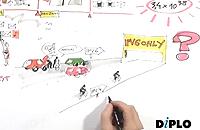
The wide range of issues covered by the field of Internet governance (IG) can sometimes be a problem to cope with. From a multistakeholder approach, across human rights and privacy issues, to the technical improvements needed and maintenance of the technical systems required for the proper running of the Internet on a best effort service base. Diversity is wide; the number of experts involved in the process is high. On an expert level, the Internet Governance Forum (IGF) is a proper way to address all IG-related questions. As Paul Wilson, from APNIC, suggested at the closing ceremony of 7th IGF in Baku, Azerbaijan: ‘There is no better way to fulfill a WSIS agenda than the IGF processes.’
But what are the questions that IG addresses? The question of future correspondence, future connectivity techniques, and how we will engage with our new work environments. Can we expand the use of the Internet to all technology? Can all devices be connected to the Internet (household devices, cars, bus stations, etc.)? Can your refrigerator send you an SMS to say that you’re running low on milk or that the cake in the fridge is two days past its expiry date?
Or should that info be monitored by The CakeCompany? Yes, it is about that indeed. All these IG questions can be reduced to a plain everyday event in our life. They are discussed at a high level by experts, but there is a need for these questions to be explained in a way that is understandable by wider audiences – especially policy makers. Not only for those completely uninvolved with the IG process, but also for the specialists on the other side of the issue’s spectre. Two engineers, one from China, and another from Poland can understand each
other using technical terms. Differences in language and culture are not a problem for them. With a great number of questions, terms, and issues interwoven into the IGF process, we at Diplo thought it is best to use a language understood by everyone – imagery.
Following this idea, Diplo’s production team, with the help of VeriSign, is releasing a series of animations, explaining some of the basic IG issues, naming it ‘Internet Governance Lite’
The first two questions we tackled are:Internet Protocol version 6 (IPv6):

and Domain Name System Security (DNSSEC):

More videos are to come.
How can these important technical changes possibly change your everyday life? How do they work, what challenges do they address – and what new challenges do they bring? Well, watch our videos to find out.
There is something magical about watching the human hand drawing a picture. It’s something that drives us to continue to pay attention until the image is finished. It makes us engage mentally, constantly guessing at the final outcome. As the magic of creation unravels before our eyes, it leaves us breathless. Therefore we tried to incorporate the ‘human touch’ into our stories. These videos are not computer generated, but rather a live video of our illustrator as he draws. We then speed up the video a few hundred times. It is indeed a true creation in process.
We are happy to have a great team of IG experts working on an understandable, clear text accommodating these videos, explaining properly how to harness the future technology and find ways to protect us from possible harm.
Below is the first one. Like the other videos, it is published under the Creative Commons license so please feel free to share them all around the Net .
We hope you will like our new series!




